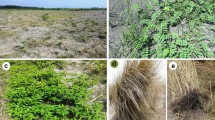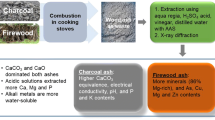Abstract
The floristic composition, the abundance, and the cover of pioneer plant species of spontaneously formed plant communities and the content of total phenolics and phenolic acids, as humus constituents, of an ash deposit after 7 years of recultivation were studied. The restoration of both the soil and the vegetation on the ash deposits of the “Nikola Tesla-A” thermoelectric power plant in Obrenovac (Serbia) is an extremely slow process. Unfavorable physical and chemical characteristics, the toxicity of fly ash, and extreme microclimatic conditions prevented the development of compact plant cover. The abundance and cover of plants increased from the central part of the deposit towards its edges (ranging from 1–80%). Festuca rubra L., Crepis setosa Hall., Erigeron canadensis L., Cirsium arvense (L.) Scop., Calamagrostis epigeios (L.) Roth., and Tamarix gallica L. were the most abundant species, thus giving the highest cover. Humus generated during the decomposition process of plant remains represents a completely new product absent in the ash as the starting material. The amount of total phenolics and phenolic acids (38.07–185.16 μg/g of total phenolics and 4.12–27.28 μg/g of phenolic acids) in fly ash increased from the center of the deposit towards its edges in correlation with the increase in plant abundance and cover. Ash samples contained high amounts of ferulic, vanillic, and p-coumaric acid, while the content of both p-hydroxybenzoic and syringic acid was relatively low. The presence of phenolic acids indicates the ongoing process of humus formation in the ash, in which the most abundant pioneer plants of spontaneously formed plant communities play the main role. Phenolic compounds can serve as reliable bioindicators in an assessment of the success of the recultivation process of thermoelectric power plants’ ash deposits.





Similar content being viewed by others
References
Adriano DC, Page AL, Elseewi AA, Chang AC, Straughan I (1980) Utilization and disposal of fly ash and other coal residues in terrestrial ecosystems: A review. J Environ Qual 9:333–334
Alexander M (1977) Lignin decomposition. In: Introduction to soil microbiology, 2nd ed. John Wiley and Sons, New York, pp 174–187
Bååth E, Frostegård Å, Pennanen T, Fritze H (1995) Microbial community structure and pH response in relation to soil organic matter quality in wood-ash fertilized, clear-cut or burned coniferous forest soils. Soil Biol Biochem 27:229–240
Bare G, Delaunois V, Rikir R, Thonart P (1994) Bioconversion of vanillin into vanillic acid by Pseudomonas fluorescens strain Btp9-reactor design and parameters optimization. Appl Biochem Biotech 45:599–610
Bate-Smith EC (1969) Flavonoid patterns in the Monocotyledons. In: Harborne JB, Swain T (eds) Perspectives in phytochemistry. Academic Press, New York, pp 167–177
Bogdanović V (1990) The number of some microorganisms in ash deposit under Robinia pseudoacacia of the “Lazarevac” thermoelectric power plant. Soil Plant 39:139–145 (in Serbian)
Bradshaw AD, Chadwick MJ (1980) The restoration of land. University of California Press, Berkley, California
Carlson CL, Adriano DC (1991) Growth and elemental content of two tree species growing on abandoned coal fly ash basins. J Environ Qual 20:581–587
Carlson CL, Adriano DC (1993) Environmental impacts of coal combustion residues. J Environ Qual 22:227–247
Crawford DL, Crawford RL (1980) Microbial degradation of lignin. Enzyme Microb Technol 2:11–22
Djurdjević L, Dinić A, Mitrović, Pavlović P (1998a) Allelopathy of Erica carnea, a dominant species in the mixed pine forest at Maljen mountain (Serbia). In: Tsekos J, Moustakas M (eds), Progress in botanical research. Kluwer Academic Publishers, Dordrecht, pp 289–293
Djurdjević L, Dinić A, Kuzmanović A, Kalinić M (1998b) Phenolic acids (PA) and total phenols in soil, litter and dominating plant species in community Orno-Quercetum virgilianae Gajić 1952. Arch Biol Sci (Belgrade) 50:21–28
Djurdjević L, Milenković M, Pavlović P, Kostić O (1999) Allelopathic investigations in the Fraxino angustifoliale-Quercetum roboris (Jov. et Tomić 1979) forest community with the autumnal truffle (Tuber macrosporum Vitt.). Arch Biol Sci (Belgrade) 51:27–33
Djurdjević L, Dinić A, Stojčić V, Mitrović M, Pavlović P, Oldja M (2000) Allelopathy of Paeonia officinalis L. 1753 ssp. banatica (Rochel) Soo 1945, a Pannonian endemic and relict species. Arch Biol Sci (Belgrade) 52:195–201
Djurdjević L, Dinić A, Mitrović M, Pavlović P, Tešević V (2003) Phenolic acids distribution in a peat of the relict community with Serbian spruce in the Tara Mt. forest reserve (Serbia). Eur J Soil Biol 39:97–103
Djurdjević L, Dinić A, Pavlović P, Mitrović M, Karadžić B, Tešević V (2004) Allelopathic potential of Allium ursinum L. Biochem System Ecol 32:533–544
Dosskey MG, Adriano DC (1993) Trace element toxicity in VA mycorrhizal cucumber grown on weathered coal fly ash. Soil Biol Biochem 25:1547–1552
Dželetović S, Filipović R (1995) Grain characteristics of crops grown on power plant ash and bottom slag deposit. Resourc Conserv Recycl 13:105–113
Ellenberg H (1956) Grundlagen der Vegetation Sliederung. 1. Teil: Aufgaben und Methoden der Vegetationskunde. In: Walter H (ed) Einfuhrung in die Phitologie, vol. IV. Ulmer, Stuttgart
Felbeck GTJR (1971) Structural hypothesis of soil humic acids. Soil Sci 111:42–48
Feldman AW, Hanks RW (1968) Phenolic content in the roots and leaves of tolerant and susceptible citrus cultivars attacked by Rodopholus similis. Phytochemistry 7:5–12
Filipović R, Simić S, Stojanović D, Dražić G, Dželetović Ž, Lazarević M (1993) Power plants as potential sources of pollution to ecosystems, with special attention to ash deposits. Energetics of Belgrade, status and perspectives, Society of Engineers and Technicians of Belgrade, Proceedings, pp 371–379
Gallet C, Nilsson MC, Zackrisson O (1999) Phenolic metabolites of ecological significance in Empetrum hermaphroditum leaves and associated humus. Plant and Soil 210:1–9
Guenzi WD, McCalla TM (1966) Phytotoxic substances extracted from soil. Soil Sci Soc Am Proc 30:214–216
Haering KC, Daniels LW (1991) Fly ash: Characteristics and use in mined land reclamation: a literature review. Virginia Coal Energy Res J 3:33–46
Harborne JB (1980) Plant phenolics. In: Secondary plant products. In: Bell EA, Charlwod BV (eds) Encyclopedia of Plant Physiology, New series. Springer-Verlag, New York, 8, pp 329–402
Haworth RD (1971) The chemical nature of humic acid. Soil Sci 111:71–79
Hennequin JR, Juste C (1967) Présence d’acides phenols libre dans le sol: Etude de leur influence sur la germination et la croissance des vegétaux. Ann Agron 18:545–569
Hodgson DR, Townsend WN (1973) The amelioration and revegetation of pulverized fuel ash. In: Hutnik RJ, Davis G (eds), Ecology and reclamation of devastated land, Vol. 2, Gordon and Breach, London, pp 247–270
Katase T (1981a) The different forms in which p-coumaric acid exists in a peat soil. Soil Sci 131:271–275
Katase T (1981b) The different forms in which p-hydroxybenzoic, vanillic, and ferulic acids exist in a peat soil. Soil Sci 132:436–443
Knežević D, Grbović B, Jovičić Ž, Djuknić P, Stupar S, Dražević D (1991) Ash deposits as air pollutions and measures of protection. In: Proceedings of Influence of Power Plants in Belgrade Zone in Air Quality Symposium, 17–18 October 1991, Belgrade, Yugoslavia (in Serbian), pp 77–86
Kögel I (1986) Estimation and decomposition pattern of the lignin component in forest humus layers. Soil Biol Biochem 18:589–594
Kögel I, Bochter R (1985) Characterization of lignin in forest humus layers by high-performance liquid chromatography of cupric oxide oxidation products. Soil Biol Biochem 17:637–640
Kögel-Knabner I (2002) The macromolecular organic composition of plant and microbial residues as inputs to soil organic matter. Soil Biol Biochem 34:139–162
Kuiters AT, Denneman CAJ (1987) Water-soluble phenolic substances in soils under several coniferous and deciduous tree species. Soil Biol Biochem 19:765–769
Landolt E (1977) Oekologische Zeigerwerte zur Schweizer Flora. Geobot Inst ETH, Zurich.
Liiri M, Haimi J, Setälä H (2002) Community composition of soil microarthropods of acid forest soils as affected by wood ash application. Pedobiologia 46:108–124
Martin JP, Haider K (1969) Phenolic polymers of Stachybotrys atra, Stachybotrys chartarum and Epicoccum nigrum in relation to humic acid formation. Soil Sci 107:260–270
Martin JP, Haider K (1971) Microbial activity in relation to soil humus formation. Soil Sci 111:54–70
Pavlović P, Mitrović M, Djurdjević L (2004) An ecophysiological study of plants growing on the fly ash deposits from the “Nikola Tesla-A” thermal power station in Serbia. Environ Manage 33:654–663
Rice EL (1974) Allelopathy. Academic Press New York, San Francisco, London
Rice EL (1979) Allelopathy-an update. Botan Rev 45:15–109
Séne M, Gallet T, Doré T (2001) Phenolic compounds in a Sahelian sorghum (Sorghum bicolor) genotype (CE145-66) and associated soils. J Chem Ecol 27:81–92
Simonović B (2003) Report on waste, surface and ground waters monitoring in the “Nikola Tesla-A” thermal power station at Obrenovac. Holding Institute of General and Physical Chemistry, Belgrade, p 36
Soo R (1980) A Magyar flora es vegetatio. Akademia Kiado, Budapest
Tang CS, Young CC (1982) Collection and identification of allelopathic compounds from the undisturbed root system of Bigalta Limpograss (Hemarthria altissima). Plant Physiol 69:55–160
Tsutsuki K Esaki I, Kuwatsuka S (1994) CuO-oxidation products of peat as a key to the analysis of the paleo-environmental changes in a wetland, Soil Sci Plant Nutr 40:107–116
Westhoff V, van der Marrel E (1973) The Braun-Blanquet approach. In: Whittaker RH (ed) Handbook of Vegetation Science V. Ordination and Classification of Communities. Junk, The Hague, pp 617–726
Whitehead DC, Dibb H, Hartley RD (1983) Bound phenolic compounds in water extracts of soils, plant roots and leaf litter. Soil Biol Biochem 15:133–136
Whitmore FW (1976) Binding of ferulic acid to cell walls by peroxidases of Pinus elliottii. Phytochemistry 15:375–378
Whittaker RH, Feeny PP (1971) Allelochemicals: Chemical interaction between species. Science 171:757–770
Acknowledgments
This project was supported by the Ministry of Science, Technology and Environmental Protection of Serbia, grant No 143025. Three of the anonymous reviewers gave valuable comments for the improvement of this paper and are gratefully acknowledged. We thank Jonathan Pendlebury, lector at Belgrade University’s Faculty of Philology, for proofreading this paper.
Author information
Authors and Affiliations
Corresponding author
Rights and permissions
About this article
Cite this article
Djurdjević, L., Mitrović, M., Pavlović, P. et al. Phenolic Acids as Bioindicators of Fly Ash Deposit Revegetation. Arch Environ Contam Toxicol 50, 488–495 (2006). https://doi.org/10.1007/s00244-005-0071-2
Received:
Accepted:
Published:
Issue Date:
DOI: https://doi.org/10.1007/s00244-005-0071-2




